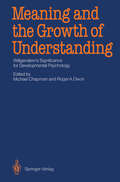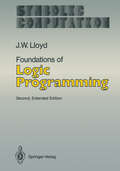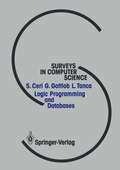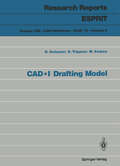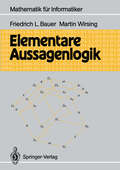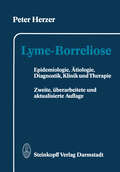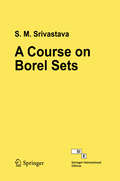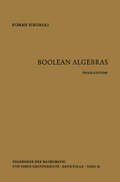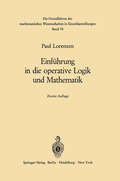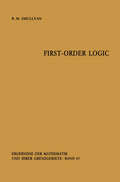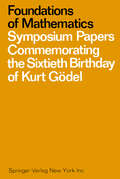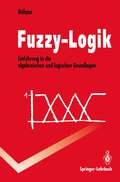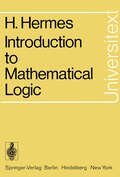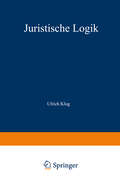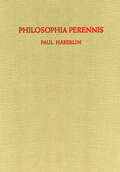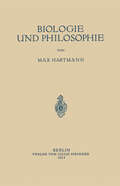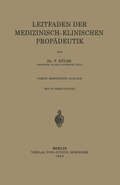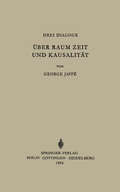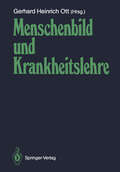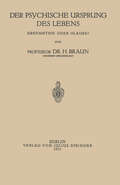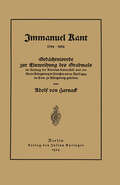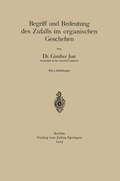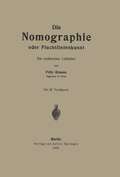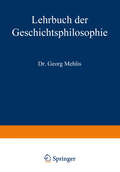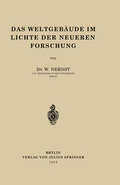- Table View
- List View
Meaning and the Growth of Understanding: Wittgenstein’s Significance for Developmental Psychology
by Roger A. Dixon MichaelChapmanIn the beginning it seemed to us that someone was missing and that something was amiss. He was often mentioned, occasionally discussed, but seldom cited or credited explicitly. And when he was acknowl edged, it was sometimes for reasons that seemed anachronistic and misleading. His influence could be felt in a number of areas of our dis cipline, but few scholars seemed to know just how, just where, and to what extent. We discovered, almost accidentally, that we shared an in terest in his legacy, in unravelling at least some portion of this riddle. Shortly thereafter, we began discussing ways in which, by pooling our resources with those of interested others, we could move closer to a res olution. Put simply, the protagonist of this riddle is Ludwig Wittgenstein (1889-1951), the son of a wealthy Viennese industrialist, the influential Cantabrigian philosopher, the rural Austrian schoolteacher. And the subject of our study is his largely unexplored legacy for developmental psychology. Although Wittgenstein's thought seemed to hold special promise for the study of human development, the philosopher and his work could walk virtually unrecognized through the landscape of con temporary developmental issues.
Foundations of Logic Programming (Symbolic Computation)
by John W. LloydIn the two and a half years since the frrst edition of this book was published, the field of logic programming has grown rapidly. Consequently, it seemed advisable to try to expand the subject matter covered in the first edition. The new material in the second edition has a strong database flavour, which reflects my own research interests over the last three years. However, despite the fact that the second edition has about 70% more material than the first edition, many worthwhile topic!! are still missing. I can only plead that the field is now too big to expect one author to cover everything. In the second edition, I discuss a larger class of programs than that discussed in the first edition. Related to this, I have also taken the opportunity to try to improve some of the earlier terminology. Firstly, I introduce "program statements", which are formulas of the form A+-W, where the head A is an atom and the body W is an arbitrary formula. A "program" is a finite set of program statements. There are various restrictions of this class. "Normal" programs are ones where the body of each program statement is a conjunction of literals. (The terminology "general", used in the first edition, is obviously now inappropriate).
Logic Programming and Databases (Surveys in Computer Science)
by Stefano Ceri Georg Gottlob Letizia TancaThe topic of logic programming and databases. has gained in creasing interest in recent years. Several events have marked the rapid evolution of this field: the selection, by the Japanese Fifth Generation Project, of Prolog and of the relational data model as the basis for the development of new machine archi tectures; the focusing of research in database theory on logic queries and on recursive query processing; and the pragmatic, application-oriented development of expert database systems and of knowledge-base systems. As a result, an enormous amount of work has been produced in the recent literature, coupled with the spontaneous growth of several advanced projects in this area. The goal of this book is to present a systematic overview of a rapidly evolving discipline, which is presently not described with the same approach in other books. We intend to introduce stu dents and researchers to this new discipline; thus we use a plain, tutorial style, and complement the description of algorithms with examples and exercises. We attempt to achieve a balance be tween theoretical foundations and technological issues; thus we present a careful introduction to the new language Datalog, but we also focus on the efficient interfacing of logic programming formalisms (such as Prolog and Datalog) with large databases.
CAD*I Drafting Model (Research Reports Esprit #4)
by Richard Schuster Dietmar Trippner Michael EndresThe content of this book is an information model for technical drawings, the so-called "Drafting Model". The Drafting Model is a part of a complex information model describing product definition data, their applications and their representations. The definition of the information model is a central component of the development of STEP, a future international standard for the exchange of product defmition data. Here the Drafting Model particularly encloses descriptions for the representations of organizational drawing data, tolerances, dimensions and surface attributes such as surface fmish symbols (a survey of the whole content is shown in the figure above). Additional to that requirements for the Presentation Model concerning the representation of geometry as well as the integration process for both the Drafting and the Presentation Models are formulated. The extent of the Drafting Model is restricted to the application area "Mechanical Engineering". Within the Drafting Model the annotation representations are described on the one hand informally and on the other hand formally using a high level language for information modeling, EXPRESS. Principally the representations of the annotation are described according to the international drawing standards. Thus the semantics pertinent to the specific graphical appearance are maintained. The data structures provide formal descriptions of annotations at a high generation level, which means that a "way" is defmed how to generate these annotations.
Elementare Aussagenlogik (Mathematik für Informatiker)
by Friedrich L. Bauer Martin WirsingDieses Buch über elementare Aussagenlogik (wie auch seine geplante Fortsetzung über Elementare Prädikatenlogik und Universelle Algebra) ist aus Vorlesungen an der Technischen Universität München entstanden. Es basiert auf der Überzeugung, daß für Studierende der Informatik nicht nur ein anderer Aufbau des mathematischen Grundstudiums geboten ist als etwa für Ingenieure oder Physiker, sondern auch ein anderes Menü, als es sich an unseren Universitäten nach den GAMM-NTG-Empfehlungen der siebziger Jahre eingebürgert hat. Neben den unentbehrlichen Einführungsvorlesungen in Mathematik sind für die Informatiker vor dem Vordiplom handwerkliche Grundkenntnisse in Logik und Universeller Algebra erforderlich - als Grundlage für die Praktische und die Theoretische Informatik im zweiten Studienabschnitt. Im Gegensatz zu vielen anderen Büchern über Logik ist dieses für den Anfänger der Informatik geschrieben und didaktisch auf sein Niveau eingestellt. Dabei sind sonst eher außerhalb der Aussagenlogik liegende Gegenstände wie die Schaltlogik systematisch einbezogen worden, wo immer es möglich war: von dem für die Programmiersprachen so wichtigen Gebiet der dyadischen Fallunterscheidungen über die Resolventenmethode, die den Anschluß an die Prädikatenlogik vorbereitet, bis zu modalen Aussagenlogiken. Die eingestreuten Übungsaufgaben greifen häufig Gedanken auf, die im Text nur nebenbei erwähnt sind, und stellen Querbezüge her. Die Lösungshinweise am Ende des Buches bieten manche Überraschungen.
A Course on Borel Sets (Graduate Texts in Mathematics #180)
by S.M. SrivastavaThe roots of Borel sets go back to the work of Baire [8]. He was trying to come to grips with the abstract notion of a function introduced by Dirich let and Riemann. According to them, a function was to be an arbitrary correspondence between objects without giving any method or procedure by which the correspondence could be established. Since all the specific functions that one studied were determined by simple analytic expressions, Baire delineated those functions that can be constructed starting from con tinuous functions and iterating the operation 0/ pointwise limit on a se quence 0/ functions. These functions are now known as Baire functions. Lebesgue [65] and Borel [19] continued this work. In [19], Borel sets were defined for the first time. In his paper, Lebesgue made a systematic study of Baire functions and introduced many tools and techniques that are used even today. Among other results, he showed that Borel functions coincide with Baire functions. The study of Borel sets got an impetus from an error in Lebesgue's paper, which was spotted by Souslin. Lebesgue was trying to prove the following: Suppose / : )R2 -- R is a Baire function such that for every x, the equation /(x,y) = 0 has a. unique solution. Then y as a function 0/ x defined by the above equation is Baire.
Boolean Algebras (Ergebnisse der Mathematik und ihrer Grenzgebiete. 2. Folge #25)
by Roman SikorskiThere are two aspects to the theory of Boolean algebras; the algebraic and the set-theoretical. A Boolean algebra can be considered as a special kind of algebraic ring, or as a generalization of the set-theoretical notion of a field of sets. Fundamental theorems in both of these directions are due to M. H. STONE, whose papers have opened a new era in the develop ment of this theory. This work treats the set-theoretical aspect, with little mention being made of the algebraic one. The book is composed of two chapters and an appendix. Chapter I is devoted to the study of Boolean algebras from the point of view of finite Boolean operations only; a greater part of its contents can be found in the books of BIRKHOFF [2J and HERMES [1]. Chapter II seems to be the first systematic study of Boolean algebras with infinite Boolean operations. To understand Chapters I and II it suffices only to know fundamental notions from general set theory and set-theoretical topology. No know ledge of lattice theory or of abstract algebra is presumed. Less familiar topological theorems are recalled, and only a few examples use more advanced topological means; but these may be omitted. All theorems in both chapters are given with full proofs.
Einführung in die operative Logik und Mathematik (Grundlehren der mathematischen Wissenschaften #78)
by Paul LorenzenFirst-Order Logic (Ergebnisse der Mathematik und ihrer Grenzgebiete. 2. Folge #43)
by Raymond R. SmullyanExcept for this preface, this study is completely self-contained. It is intended to serve both as an introduction to Quantification Theory and as an exposition of new results and techniques in "analytic" or "cut-free" methods. We use the term "analytic" to apply to any proof procedure which obeys the subformula principle (we think of such a procedure as "analysing" the formula into its successive components). Gentzen cut-free systems are perhaps the best known example of ana lytic proof procedures. Natural deduction systems, though not usually analytic, can be made so (as we demonstrated in [3]). In this study, we emphasize the tableau point of view, since we are struck by its simplicity and mathematical elegance. Chapter I is completely introductory. We begin with preliminary material on trees (necessary for the tableau method), and then treat the basic syntactic and semantic fundamentals of propositional logic. We use the term "Boolean valuation" to mean any assignment of truth values to all formulas which satisfies the usual truth-table conditions for the logical connectives. Given an assignment of truth-values to all propositional variables, the truth-values of all other formulas under this assignment is usually defined by an inductive procedure. We indicate in Chapter I how this inductive definition can be made explicit-to this end we find useful the notion of a formation tree (which we discuss earlier).
Foundations of Mathematics: Symposium Papers Commemorating the Sixtieth Birthday of Kurt Gödel
by Jack John Bulloff Thomas Campell Holyoke S. W. HahnDr. KURT GODEL'S sixtieth birthday (April 28, 1966) and the thirty fifth anniversary of the publication of his theorems on undecidability were celebrated during the 75th Anniversary Meeting of the Ohio Ac ademy of Science at The Ohio State University, Columbus, on April 22, 1966. The celebration took the form of a Festschrift Symposium on a theme supported by the late Director of The Institute for Advanced Study at Princeton, New Jersey, Dr. J. ROBERT OPPENHEIMER: "Logic, and Its Relations to Mathematics, Natural Science, and Philosophy." The symposium also celebrated the founding of Section L (Mathematical Sciences) of the Ohio Academy of Science. Salutations to Dr. GODEL were followed by the reading of papers by S. F. BARKER, H. B. CURRY, H. RUBIN, G. E. SACKS, and G. TAKEUTI, and by the announcement of in-absentia papers contributed in honor of Dr. GODEL by A. LEVY, B. MELTZER, R. M. SOLOVAY, and E. WETTE. A short discussion of "The II Beyond Godel's I" concluded the session.
Fuzzy-Logik: Einführung in die algebraischen und logischen Grundlagen (Springer-Lehrbuch)
by Gert BöhmeDer Begriff "Fuzzy" - 1965 von Lofty A. Zadeh in einer Erweiterung der gewöhnlichen Mengenlehre auf die Verknüpfung unscharfer Mengen kreiert - hat seine Anwendung in zahlreichen Gebieten der Technik gefunden. In diesem Lehrbuch erhält der Leser eine leicht verständliche Einführung in die mathematischen und logischen Grundlagen. Er soll in die Lage versetzt werden, die für die Fuzzy-Logik spezifischen algebraischen und logischen Arbeitsmethoden operativ einzusetzen. Das Lehrbuch wurde mit dem Ziel entwickelt, insbesondere im Selbststudium das Werkzeug "Fuzzy" für die berufspraktische Anwendung zu erarbeiten. Zu diesem Zweck enthält es eine große Anzahl von Beispielen aus der Anwendung sowie Aufgaben mit Lösungen. Fuzzy-Logik wendet sich gleichermaßen an Studenten der Ingenieurwissenschaften, Informatik und Wirtschaftswissenschaften, wie auch an Anwender in der industriellen Praxis, die sich in dieses aktuelle und hochbrisante Gebiet einarbeiten möchten.
Introduction to Mathematical Logic (Universitext)
by Hans HermesThis book grew out of lectures. It is intended as an introduction to classical two-valued predicate logic. The restriction to classical logic is not meant to imply that this logic is intrinsically better than other, non-classical logics; however, classical logic is a good introduction to logic because of its simplicity, and a good basis for applications because it is the foundation of classical mathematics, and thus of the exact sciences which are based on it. The book is meant primarily for mathematics students who are already acquainted with some of the fundamental concepts of mathematics, such as that of a group. It should help the reader to see for himself the advantages of a formalisation. The step from the everyday language to a formalised language, which usually creates difficulties, is dis cussed and practised thoroughly. The analysis of the way in which basic mathematical structures are approached in mathematics leads in a natural way to the semantic notion of consequence. One of the substantial achievements of modern logic has been to show that the notion of consequence can be replaced by a provably equivalent notion of derivability which is defined by means of a calculus. Today we know of many calculi which have this property.
Juristische Logik
by Ulrich Klug§ 1. Begriff der juristischen Logik 1. Wenn im folgenden von juristischer Logik und einigen ihrer Probleme die Rede sein soll, so bedarf es zunächst einer Angabe dessen, was im Zu sammenhang dieser Untersuchungen unter Logik verstanden wird. Der Aus druck Logik wird im Rahmen der Philosophie sowohl als auch innerhalb der Einzelwissenschaften in mehreren, oftmals erheblich voneinander abweichen den Bedeutungen verwandt. Der Sprachgebrauch ist sogar derart schillernd, daß einer scharfen Definition, sofern sie sich an den üblichen Sprachgebrauch anschließen soll, nicht unerhebliche Schwierigkeiten im Wege stehen, denn bekanntlich spricht man von materialer, formaler, transzendentaler, regio naler, reiner, angewandter, theoretischer, praktischer, hermeneutischer, rea ler, natürlicher, klassischer und moderner Logik, um nur einige der zahl 1 reichen Wortverknüpfungen herauszugreifen • Für die hier anzustellenden Überlegungen vereinfacht sich jedoch die Frage nach einer passenden Definition. Während nämlich die Ansichten darüber, was man etwa unter materialer oder transzendentaler Logik zu verstehen habe, weitgehend divergieren, gilt für den Begriff der formalen Logik cum grano salis das Gegenteil.
Biologie und Philosophie
by Max HartmannDieser Buchtitel ist Teil des Digitalisierungsprojekts Springer Book Archives mit Publikationen, die seit den Anfängen des Verlags von 1842 erschienen sind. Der Verlag stellt mit diesem Archiv Quellen für die historische wie auch die disziplingeschichtliche Forschung zur Verfügung, die jeweils im historischen Kontext betrachtet werden müssen. Dieser Titel erschien in der Zeit vor 1945 und wird daher in seiner zeittypischen politisch-ideologischen Ausrichtung vom Verlag nicht beworben.
Leitfaden Der Medizinisch-Klinischen Propädeutik
by F. KülbsDieser Buchtitel ist Teil des Digitalisierungsprojekts Springer Book Archives mit Publikationen, die seit den Anfängen des Verlags von 1842 erschienen sind. Der Verlag stellt mit diesem Archiv Quellen für die historische wie auch die disziplingeschichtliche Forschung zur Verfügung, die jeweils im historischen Kontext betrachtet werden müssen. Dieser Titel erschien in der Zeit vor 1945 und wird daher in seiner zeittypischen politisch-ideologischen Ausrichtung vom Verlag nicht beworben.
Menschenbild und Krankheitslehre
by Gerhard H. OttDieses Buch enthält Beiträge zum Thema Heilungswirkung der modernen Kunst. Über naturwissenschaftliche Methoden hinausgehend setzen sich die Autoren mit der Frage psychisch heilender Einflüsse und der Krankheitsbewältigung des Patienten auseinander.
Der Psychische Ursprung des Lebens: Erkenntnis oder Glaube?
by NA BraunDieser Buchtitel ist Teil des Digitalisierungsprojekts Springer Book Archives mit Publikationen, die seit den Anfängen des Verlags von 1842 erschienen sind. Der Verlag stellt mit diesem Archiv Quellen für die historische wie auch die disziplingeschichtliche Forschung zur Verfügung, die jeweils im historischen Kontext betrachtet werden müssen. Dieser Titel erschien in der Zeit vor 1945 und wird daher in seiner zeittypischen politisch-ideologischen Ausrichtung vom Verlag nicht beworben.
Immanuel Kant (1724–1924): Gedächtnisrede zur Einweihung des Grabmals Im Auftrag der Albertus-Universität und der Stadt Königsberg in Preußen am 21. April 1924 im Dom zu Königsberg gehalten
by Ernst von HarnackDieser Buchtitel ist Teil des Digitalisierungsprojekts Springer Book Archives mit Publikationen, die seit den Anfängen des Verlags von 1842 erschienen sind. Der Verlag stellt mit diesem Archiv Quellen für die historische wie auch die disziplingeschichtliche Forschung zur Verfügung, die jeweils im historischen Kontext betrachtet werden müssen. Dieser Titel erschien in der Zeit vor 1945 und wird daher in seiner zeittypischen politisch-ideologischen Ausrichtung vom Verlag nicht beworben.
Begriff und Bedeutung des Zufalls im organischen Geschehen
by Günther JustDieser Buchtitel ist Teil des Digitalisierungsprojekts Springer Book Archives mit Publikationen, die seit den Anfängen des Verlags von 1842 erschienen sind. Der Verlag stellt mit diesem Archiv Quellen für die historische wie auch die disziplingeschichtliche Forschung zur Verfügung, die jeweils im historischen Kontext betrachtet werden müssen. Dieser Titel erschien in der Zeit vor 1945 und wird daher in seiner zeittypischen politisch-ideologischen Ausrichtung vom Verlag nicht beworben.
Die Nomographie oder Fluchtlinienkunst: Ein technischer Leitfaden
by Fritz KraussDieser Buchtitel ist Teil des Digitalisierungsprojekts Springer Book Archives mit Publikationen, die seit den Anfängen des Verlags von 1842 erschienen sind. Der Verlag stellt mit diesem Archiv Quellen für die historische wie auch die disziplingeschichtliche Forschung zur Verfügung, die jeweils im historischen Kontext betrachtet werden müssen. Dieser Titel erschien in der Zeit vor 1945 und wird daher in seiner zeittypischen politisch-ideologischen Ausrichtung vom Verlag nicht beworben.
Lehrbuch der Geschichtsphilosophie
by Georg MehlisDieser Buchtitel ist Teil des Digitalisierungsprojekts Springer Book Archives mit Publikationen, die seit den Anfängen des Verlags von 1842 erschienen sind. Der Verlag stellt mit diesem Archiv Quellen für die historische wie auch die disziplingeschichtliche Forschung zur Verfügung, die jeweils im historischen Kontext betrachtet werden müssen. Dieser Titel erschien in der Zeit vor 1945 und wird daher in seiner zeittypischen politisch-ideologischen Ausrichtung vom Verlag nicht beworben.
Das Weltgebäude im Lichte der Neueren Forschung
by W. NernstDieser Buchtitel ist Teil des Digitalisierungsprojekts Springer Book Archives mit Publikationen, die seit den Anfängen des Verlags von 1842 erschienen sind. Der Verlag stellt mit diesem Archiv Quellen für die historische wie auch die disziplingeschichtliche Forschung zur Verfügung, die jeweils im historischen Kontext betrachtet werden müssen. Dieser Titel erschien in der Zeit vor 1945 und wird daher in seiner zeittypischen politisch-ideologischen Ausrichtung vom Verlag nicht beworben.
